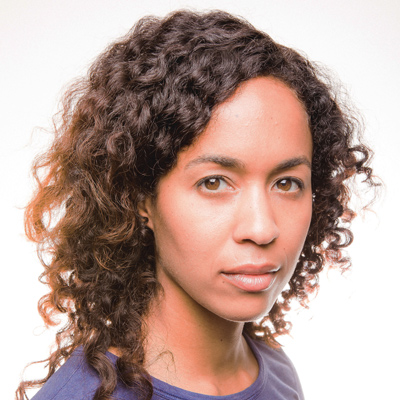Hallie Gordon: Welcome to KCRep! I know you had an opportunity to work with Stuart Carden in the past on a different production of The Royale, but this is your first time with this show as a director. Of the piece, can you talk about how your multi-faceted work as an artist, choreographer and body percussionist helped you shape the characters in the play?

Steph Paul: I’ve worked on The Royale three times — once with Jaime Casteñada , and the most recent two times with Stuart Carden. I am proud to be here for “Round Four!” This is a show that resonates deep in my heart and my body. To now experience it through the lens of both director and choreographer is pretty thrilling.
Marco Ramirez’ writing demands attention and respect to the rhythm of the language. And I’m not even talking about the claps yet. The verbal language on its own is rhythmic gold. And then to add the body percussion to the mix — incredible! What I love is each language is as important as the other; the verbal and body expression are on an equal playing field.
This is the type of work I’m attracted to. It allows me as a multi-hyphenate artist to collaborate in shaping fully realized and expressive humans that have access to their most expansive selves. So for example, when I’m thinking about Jay, I’m not just thinking about his story. I’m thinking about his physical flow, his musical anthem, the way the language rolls off the tongue, how he sees the world, how he feels the world, how he lives in his own body, etc. This is the type of play that encourages me to bring my full toolbox and self to the room.
Hallie : I have been lucky enough to see your work in the past. I believe your artistry started out with a focus on choreography. In your dance/movement work, you have the skill to work with all ages, all body types, and also the ability to cross-dance genres (is that that right way to phrase that?) I love that about your work! Can you talk a bit about what drew you to this work and how story resonates so deeply in your movement work?
Steph: When I was in college I was in a performance group called Boomshaka. It was there I learned to drum, both with sticks and with my body. It was also the first time I fully comprehended that I was alive in a much more transcendent way than I had previously thought possible.
Have you ever had an experience that made you go: “OH! I’m awake now!” This is how I felt when I began to connect my body to the ground and play the instrument that was ME. I was both the percussionist and the drum. It’s a hell of a feeling! This growth within myself — going from non-drummer to drummer, writing my own rhythms, eventually directing that ensemble and trusting myself as a leader — that whole journey contributed greatly to where I am now. It’s had an impact on my belief in myself and my belief in others.
We all carry our instruments. We are all capable. So often we just need some encouragement and someone to clear space for us to fly.
And when it comes to story, that’s always been embedded in my work. Don’t get me wrong, I’m here for a carefree 5-6-7-8 dance break, but our bodies are natural storytellers. In my work I seek to give the body the mic and let it speak for itself.
Hallie: The script gives you a bit of a road map rhythmically to the boxing. How do you take that information and transform it into body percussion that speaks its own language and yet is telling the story of the play?
Steph: This is tricky! It’s a delicate balance because this piece could easily be turned into a non-stop drum show. But that’s not what the play is actually about. The percussion is a tool to tell the story; it’s not actually the story.My goal is to create music that honors the truth on the page and on the stage.
And yes, of course, the creative artist in me wants the music to be exciting and for it to electrify our audiences! My goal is to both invigorate the room AND serve the story.
Hallie: What first drew you to the story of The Royale and Jack Johnson? What does this piece mean to you?
Steph: Every time I read about Jack Johnson, I’m blown away. We are talking early 1900s, son of slaves, flaunting his money, his power, his women. He was a champion. He was the best!
Jack lived life loudly. And he had every right to. But the world wasn’t ready. So what does it mean when YOU are ready to live out your greatness and take up space, but there are stop signs in every direction? I think often of Jack’s strength and resilience. No one should have to be that strong. But he was.
The gift this piece continues to give is it encourages me to rethink the often rosy-colored glasses narrative we’ve been fed about the breaking of the color line in sports. Yes, those who broke the line (Jackie Robinson – MLB, Earl Lloyd – NBA, etc) were straight up ballers, heroes and champions. They deserve nothing but respect and glory. But the ugly truth is they also were the first black athletes for their respective leagues that white people invited into the club.
So what does it mean to hold these multitudes? To celebrate the undeniable talent, tenacity and courage of these athletes and to confront head-on the power of the white gatekeeper. To engage with this work critically, we must do both.